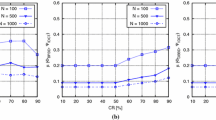Abstract
An Amplitude Shift Keying (ASK) transceiver for RFID applications is presented in this paper. The proposed transceiver is suitable for communications with electronic devices that are powered through an inductive link. The circuit has been designed to be compatible with the communication standards ISO 14443. It operates at 13.56 MHz with a communication speed from 200 kHz up to 847 kHz. In modulation mode of operation, a solution based on programmable CMOS inverters is proposed to control the modulation depth in the range [0–100%]. The demodulator has been designed using versatile current rectifier and a simple operational transconductance amplifier stage. The proposed transceiver was implemented in a standard 0.5 μm CMOS process. The circuit covers an area of 2 mm2 and the total DC power consumption is lower than 5.3 mW under 4V DC supply voltage.
Similar content being viewed by others
References
G. Gudnason, “A low-power ASK demodulator for inductively coupled implantable electronics.” 26th European Solid-State Circuits Conference, Stockholm, Sweden, 19–21 September 2000, pp. 385–388.
U. Kaiser, and W. Steinhagen, “A low-power transponder IC for high-frequency identification systems.” IEEE Journal of Solid-State Circuits, vol. 30, no. 3, pp. 306–310, 1995.
D. Friedman, H. Heinrich, and Y. Heights, “A low power CMOS integrated circuit for field-Powered radio frequency identification Tags” 1997 IEEE International Solid-State Circuits Conference, pp. 294–295 & 474.
Q. Huang, and M. Oberle, “A 0.5 mW passive telemetry IC for biomedical application.” IEEE Journal of Solid State Circuits, vol. 33, no. 7, pp. 937–946, 1998.
Thomas H. Lee, The Design of CMOS Radio Frequency Integrated Circuits. Cambridge University Press, 1998, ISBN 0-521- 63922–0.
K. Finkenzeller, RFID Handbook, Radio Frequency Identification: Fundamentals and Identification. John Wiley & Sons Inc., 1999.
A. Djemouai, M. Sawan, and M. Slamani, “A efficient RF power transfer and bidirectional data transmission to implantable electronic devices.” IEEE International Symposium on Circuits and Systems, vol. 2, pp. 259–262, 1999.
S. Masui, E. Ishii, T. Iwawaki, Y. Sugawara, and K. Sawada, “A 13. 56 MHz CMOS RF identification transponder integrated circuit with a dedicated CPU.” IEEE International Solid-State Circuits Conference, 1999 pp. 162–163.
R. Puers, M. Catrysse, R.J. Collier, E. Louridas, F. Burny, M. Donkerwolcke, and F. Moulart, “A telemetry system for the detection of hip prosthesis loosening by vibration analysis.” Elsevier Journal of Sensors and Actuators, no. 85, pp. 42–47, 2000.
Microchip, “microIDTM 13.56 MHz RFID system design guid.” 1999 microchip technology Inc., July 1999/DS21299C.
C. Toumazou, F.J. Lidgey, and D.G. Haigh, Analog IC Design: the Current Mode Approach. Peter Peregrinus, Edit 1990, UK, Londres.
ISO/IEC 14443–2 et ISO/IEC 15693–2– International Organization for Standardization, http://www.iso.ch
R.J. Barker, H.W. Li, and D.E. Boyce, CMOS Circuit Design, Layout, and Simulation. IEEE Press Serie on Microelectronic Systems, S.K. Tewksbury, series Editor, New York 1998.
Author information
Authors and Affiliations
Corresponding author
Additional information
Stéphane Meillére has received the Engineer degree in Microelectronics from the ISEN-Toulon, Institut Supérieur d’Electronique et du Numérique, School at Toulon in 2000 and the M.Sc. and Ph.D. degrees from the University of Provence Aix-Marseille I, France, in 2000 and 2004, respectively, all in Microelectonics.
From 2003 to 2005, he worked as a Research Engineer at the ISEN-Toulon. Since 2005 he joined the University of Provence as an Assistant Professor. His research interests are mainly in the design of full custom ASICs. He integrated in the same time the Integrated Circuits Design Team at the L2MP laboratory. He worked on different research project with industry.
Hervé Barthélemy has received the MSc degree in Electrical Engineering in 1992 and the PhD degree in Electronics from the University of Paris XI Orsay, France in 1996. In 2002 he received the HDR degree from the University of Provence, Aix-Marseille I, France. From 1996 to 2000 he was an Assistant Professor at the Institut Supérieur d’Electronique de la Méditerranée (ISEN) in Toulon, France. Since 2000 he joined the University of Provence where is has been a full Professor in 2005. Since 2005 he has headed the Integrated Circuits Design Team at the L2MP laboratory. The team counts 12 Researchers and 20 PhD students and is involved in several research projects with industry. His research interests are mainly in the design of radiofrequency analog integrated circuits. He authored and co-authored multiple publications in international journals and conference proceeding.
Michel Martin received an engineering degree in applied physics, option Micro-electronics from Ecole Nationale Supérieure de Physics in Marseille in 1991. He worked previously in ST Microelectronics, and he was involved in the design of the Smart Card Group’s product. He joined Gemplus in ’91 where he designed chips for secured smart cards memories. In 1995, he was the Co-founder of INSIDE Contactless. He was involved in the analog and EEPROM memories designs for contact and contactless chips. Michel was promoted I.C. Design Director with a team of 15 people divided on 2 Design Centers. He still maintains an active part in the chip Design. He is also the responsible for technical interface with the foundries to develop EEPROM memory bit cell, and improve the new processes dedicated the smart cards application.
Rights and permissions
About this article
Cite this article
Meillère, S., Barthélemy, H. & Martin, M. 13.56 MHz CMOS transceiver for RFID applications. Analog Integr Circ Sig Process 49, 249–256 (2006). https://doi.org/10.1007/s10470-006-0392-8
Received:
Revised:
Accepted:
Published:
Issue Date:
DOI: https://doi.org/10.1007/s10470-006-0392-8




